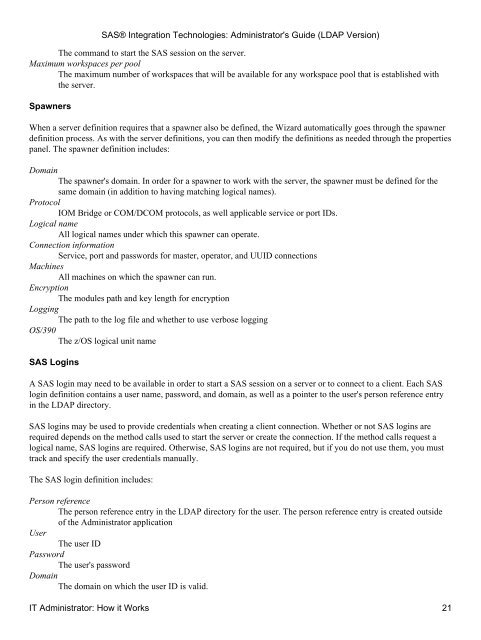SAS® Integration Technologies: Administrator's Guide (LDAP Version)
SAS® Integration Technologies: Administrator's Guide (LDAP Version)
SAS® Integration Technologies: Administrator's Guide (LDAP Version)
Create successful ePaper yourself
Turn your PDF publications into a flip-book with our unique Google optimized e-Paper software.
The command to start the SAS session on the server.<br />
Maximum workspaces per pool<br />
The maximum number of workspaces that will be available for any workspace pool that is established with<br />
the server.<br />
Spawners<br />
When a server definition requires that a spawner also be defined, the Wizard automatically goes through the spawner<br />
definition process. As with the server definitions, you can then modify the definitions as needed through the properties<br />
panel. The spawner definition includes:<br />
Domain<br />
The spawner's domain. In order for a spawner to work with the server, the spawner must be defined for the<br />
same domain (in addition to having matching logical names).<br />
Protocol<br />
IOM Bridge or COM/DCOM protocols, as well applicable service or port IDs.<br />
Logical name<br />
All logical names under which this spawner can operate.<br />
Connection information<br />
Service, port and passwords for master, operator, and UUID connections<br />
Machines<br />
All machines on which the spawner can run.<br />
Encryption<br />
The modules path and key length for encryption<br />
Logging<br />
The path to the log file and whether to use verbose logging<br />
OS/390<br />
The z/OS logical unit name<br />
SAS Logins<br />
A SAS login may need to be available in order to start a SAS session on a server or to connect to a client. Each SAS<br />
login definition contains a user name, password, and domain, as well as a pointer to the user's person reference entry<br />
in the <strong>LDAP</strong> directory.<br />
SAS logins may be used to provide credentials when creating a client connection. Whether or not SAS logins are<br />
required depends on the method calls used to start the server or create the connection. If the method calls request a<br />
logical name, SAS logins are required. Otherwise, SAS logins are not required, but if you do not use them, you must<br />
track and specify the user credentials manually.<br />
The SAS login definition includes:<br />
<strong>SAS®</strong> <strong>Integration</strong> <strong>Technologies</strong>: <strong>Administrator's</strong> <strong>Guide</strong> (<strong>LDAP</strong> <strong>Version</strong>)<br />
Person reference<br />
The person reference entry in the <strong>LDAP</strong> directory for the user. The person reference entry is created outside<br />
of the Administrator application<br />
User<br />
The user ID<br />
Password<br />
The user's password<br />
Domain<br />
The domain on which the user ID is valid.<br />
IT Administrator: How it Works 21
















